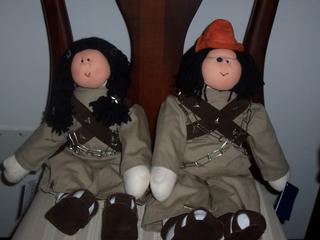T-e-r-r-o-r-i-s-t-s Among Us

For my birthday back in July, Mark bought me two dolls -- Lampião and Maria Bonita, two of the most popular folk heros of Pernambuco and the Brazilian Northeast. These two are everywhere! They can be found in abundance as clay figurines, wood carvings, as etched engravings, on the covers of folk literature, and as life size cut-out dolls so that you too can be Lampião and Maria Bonita. From the little that we knew about Lampião, it seemed that he was some kind of Robin Hood figure for the Brazilian Northeast back in the 1920s and 30s. Fighting against the machine, robbing from the rich and giving to the poor, Lampião and Maria Bonita were the leaders of a gang of (mostly) men, called cangaceiros, who roamed the backwoods defying the law and living off the generosity of the poor exploited peasants.
Now that I had these two cuddly dolls in my possession, it seemed to me that I should do a little bit of research to find out just who Lampião and Maria Bonita were. Well. Imagine my shock when I discovered that Lampião and Maria Bonita were simply bad bad people [at least that is what most of the literature says ...]. No revolutionary, hero-of-the-poor going on here. Lampião -- whose real name was Virgulino Ferreira da Silva -- was born in 1897 in the semi-arid backlands of Pernambuco. Life was tough and the local peasants ecked out their livings subject to the rule of large landholders and political bosses. Virgulino's family was involved in a vicious family feud [not such an uncommon thing ....] and his father was killed during a police raid when Virgulino was in his early twenties. Vowing revenge, he headed into the bush and became Lamipão, a deadly bandit who raided, looted, killed, and terrorized. According to one account, the most positive thing that could happen would be that if he had nothing personal against a particular town or village, he would throw a party with lots of music and cachaça. Other than that, these guys were nasty. Pure nasty. The peasants who collaborated did so mostly out of extreme fear.
In 1938, the cangaceiros were betrayed and Lamipão and Maria Bonita were killed in a surprise attack. The attacking soldiers cut off the heads of the dead [approximately a dozen] cangaceiros and sent them off to the city of Salvador where they were examined and then put on display for over thirty years. It was only in 1971 that the heads were returned to the families -- Lamipão and Maria Bonita had one daughter in 1932 -- for proper burial. And now these two are huge folk heros and can be found in every tourist stall for sale in some form or another. More info on Lamipão, including pictures of their heads on display [kind of gruesome, you have been warned] can be found here and here.
More info on Lamipão, including pictures of their heads on display [kind of gruesome, you have been warned] can be found here and here.


1 Comments:
Again, a very interesting story. I can go home and go back to bed now that I've learned something new for the day!
Post a Comment
<< Home